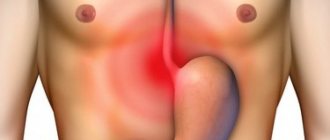Have you been struggling with GASTRITIS and ULCERS for many years without success?
“You will be amazed at how easy it is to cure gastritis and ulcers just by taking it every day...
Read more "
Abdominal pain in a person above the navel can occur suddenly and in most cases it indicates the development of pathologies in organs located in the epigastric zone. Some people do not pay attention to the pain just above the navel, which is why their illness becomes chronic and is accompanied by frequent recurrences. The pain that occurs above the navel in the center can have a pressing, stabbing, cutting, aching and dull form and varying degrees of intensity. It can have precise localization and can also radiate to other parts of the body.
What is located above the navel in people?
If a person’s stomach hurts a lot just above the navel, this may indicate problems in the gastrointestinal tract. If the pain is above the navel and a little higher, then in 80% of examined patients, specialists identify disturbances in the functioning of the digestive system.
Pain in a person in the center of the abdomen above the navel can occur with the development of the following pathologies:
- IBS;
- bile duct dyskinesia;
- dyspepsia.
20% of the examined patients have pain above the navel, which indicates the development of the following diseases:
- neoplasms (benign or malignant);
- pancreatitis;
- cholecystitis;
- ulcerative pathology in the duodenum or stomach;
- gastroduodenitis;
- different forms of gastritis.
Prevention
To prevent similar situations from arising in the future, you need to carefully monitor your own lifestyle. Play sports, eat right, and don’t overeat on heavy or unhealthy foods. Try to do everything to maintain stable functioning of the body. Visit the hospital once a year, listen to what the doctor says, and do not neglect his advice. Give up bad habits: alcohol, smoking and drugs. Try to be less nervous.
Pain above the navel, which appears suddenly or has been present for some time, may indicate that symptoms of a certain disease have appeared in the body. It could be the first serious wake-up call.
Pain, if it is severe or constantly aching, gives a person a lot of trouble, he is forced to constantly be distracted by it and cannot calmly work, walk, sit, etc. Therefore, here you need to immediately begin to solve this problem by finding out why the symptom arose.
Reasons why the stomach hurts above the navel
| Gastrointestinal diseases | What is located just above the navel, a description of pathologies that can cause pain |
| Functional dyspepsia | People more often develop epigastric pain syndrome, in which the focus is localized just above the navel. At the same time, heartburn, heaviness in the stomach, belching, bloating, and vomiting may appear. |
| Dyskinesia | Dull pain in the abdomen, localized above the navel, occurs with a hypokinetic variant of the disease. In the hyperkinetic form of the pathology, patients complain of short-term attacks of pain, general weakness, a bitter taste, and disruption of bowel movements. |
| IBS | If a person has pain above the umbilical area, this may indicate the development of irritable bowel syndrome. Patients experience abdominal bloating, frequent bowel movements, diarrhea and constipation |
| Gastritis | If the stomach hurts above the navel, the causes of discomfort in women and men may lie in the development of gastritis. In parallel, the following symptoms are observed: heartburn, feeling of heaviness, belching, etc. |
| Cholecystitis | If the pain is just above the navel, a little to the right, then this may indicate the development of a non-calculous or calculous form of cholecystitis |
| Ulcerative pathology | When this disease develops, people most often experience pain immediately after meals, as well as at night. The intensity of discomfort decreases an hour after eating |
| Chronic or acute form of pancreatitis | People who develop inflammation in the pancreas often experience girdle pain, which can also be localized in the umbilical area. At the same time, vomiting, heartburn, bloating are observed, defecation processes are disrupted, and there is a feeling of a full stomach |
What else can hurt above the navel?
| Diseases | What is in people above the navel in the middle, a description of pathologies that can cause pain |
| Neoplasms (benign or malignant) | As a rule, people think about why their stomach hurts above the navel when the disease is already advanced and requires surgical treatment. In this case, pain can have varying degrees of intensity and radiate from the umbilical zone to other parts of the peritoneum. |
| Appendicitis | Initially, inflammation of the appendix manifests itself as pain in the umbilical zone, which over time radiates to the iliac region |
What else hurts above the navel?
People may experience pain in the umbilical area with the development of the following pathologies:
- Myocardial infarction (abdominal form).
- Solarita.
- Neuropathies.
- Enterites.
- Colitis, etc.
Pain in the stomach during myocardial infarction
Myocardial infarction is a disease of the heart muscle deprived of blood and oxygen. An area is formed in the myocardium with zones of necrosis and ischemia. One of the variants of the atypical course is the gastralgic form. It is most typical for damage to the posterior wall of the left ventricle.
It is impossible to distinguish the pain from epigastric diseases by the nature of the pain. Additional symptoms help in diagnosis:
- the patient experiences shortness of breath at rest or with little physical exertion;
- palpitations, arrhythmia;
- blood pressure response;
- lack of connection between pain and food intake.
What is this symptom if it hurts above the navel?
Modern medicine separately identifies “red flag” symptoms, which indicate the development of life-threatening pathologies.
As a rule, if such signs are present, patients require emergency hospitalization followed by surgical intervention. In parallel with pain in the umbilical area, people experience the following symptoms:
- Vomiting begins. In this category of patients, the vomit acquires a consistency similar to coffee grounds. They often contain blood impurities. Also, blood streaks and clots are found in the stool, causing it to change color and become black.
- A dagger-shaped pain syndrome occurs in the epigastric zone.
- The patient's swallowing functions are impaired.
- On the anterior wall of the peritoneum, muscle tissue tension is observed, which indicates the development of peritonitis.
- Unreasonable weight loss occurs. People develop disgust even for their favorite foods. This condition indicates the development of neoplasms.
- There are signs of intestinal obstruction, in which foul-smelling belching, vomiting, and constipation appear. The development of pyloric stenosis may occur.
- In people over 45 years of age, symptoms appear that indicate damage to the gastrointestinal tract.
- With progressive weakness, increased sweating, and fainting conditions, the intensity of the pain syndrome may decrease. This will indicate new bleeding.
Pain due to lesions of the spleen
Pain is caused by stretching of the spleen capsule. It is characterized by massive innervation and responds to swelling and enlargement of the organ. Abscess and infarction of the spleen can also cause pain. The intensity is more similar to the feeling of heaviness in the left hypochondrium and epigastrium.
Enlargement of the spleen occurs:
- for acute and chronic infectious diseases (tuberculosis, infectious mononucleosis, malaria, septic condition);
- massive hemolysis of red blood cells (hemolytic anemia, long-term hemodialysis);
- blood deposition and congestive enlargement due to portal hypertension;
- autoimmune diseases (systemic lupus erythematosus);
- blood diseases (lymphomas, lymphocytic leukemia, myeloid leukemia).
In addition to pain, hypersplenism syndrome is manifested by: a decrease in all blood cells (pancytopenia), severe anemia (pallor, shortness of breath, weakness, dizziness), a tendency to infections and bleeding.
Gynecological pathologies
Despite the fact that almost all gynecological diseases are accompanied by pain in the lower abdomen, there are a number of ailments in which they can be localized in the umbilical area. Discomfort that occurs above the navel may indicate the development of pathological processes in the uterus and appendages. Approximately 11% of women turn to gynecologists with such complaints, in whom gastroenterologists have not identified any problems with the gastrointestinal tract.
Modern medicine knows the following gynecological diseases, in which the pain syndrome can be localized in the umbilical area:
- Myoma . This benign neoplasm does not cause any discomfort in the initial stage. It can be diagnosed by specialists during a routine examination of patients, noticing nodules in the uterus. Over time, especially in the presence of provoking factors, the nodes begin to increase in size and form into a tumor. Such a benign neoplasm provokes menstrual bleeding and pain. If a woman does not control the growth of fibroids (this can be done through hormone-containing drugs, as well as through the installation of a hormonal spiral), then the formation may rupture, the exudate present in it will penetrate the peritoneum and provoke the development of peritonitis.
- Cysts . Benign neoplasms are localized on the ovaries. If a woman has a functional cyst, then, as a rule, it bursts during the cycle. Other types of formations pose a serious threat to the lives of patients and therefore require surgical treatment.
- Tubal pregnancy . When a fallopian tube ruptures, a woman begins to experience excruciating pain that is localized throughout the entire abdominal area, particularly in the navel area. This pathological condition requires immediate surgical intervention, otherwise everything will end fatally for the patient.
Experts strongly recommend that the following categories of patients with pain in the navel area be examined by gynecologists:
- Women who have irregular menstrual cycles.
- Those who have a history of pathologies of the appendages or uterus.
- Women who have been diagnosed with various neoplasms, in particular polyps, cysts, fibroids.
- For mothers who gave birth to babies no more than 4 months ago.
- Women who have multiple sexual partners.
- For patients whose periods are accompanied by severe pain and heavy discharge that does not stop for 7 days.
Pain due to abdominal aortic aneurysm
If a person over 50 years of age complains of epigastric pain, it can be assumed that he has significant atherosclerotic damage in the form of deposition of cholesterol plaques into the wall of the abdominal aorta.
The loss of elasticity of a section of a large vessel passing in the epigastric zone contributes to the gradual formation of an expansion with thinned walls. The tissue around the aneurysm becomes inflamed. When large in size, it can compress the stomach, inferior vena cava, intestines, and liver.
Pressure on the spine may cause sensory disturbances and paralysis in the legs. The pain lasts for several hours. Appear in the late afternoon or at night. An aneurysm is revealed by palpation of the abdomen in the form of a large pulsating tumor.
What can hurt a child above the navel inside?
If a child has severe pain in the abdomen above the navel, then he needs to urgently call an ambulance, as this is a symptom of an inflamed appendix of the cecum.
Pain syndrome can also develop in children for the following reasons:
- Experienced stressful situations.
- Individual lactose intolerance. As a rule, discomfort occurs due to the introduction of milk and dairy products into the baby's diet. If the baby’s body does not produce lactase enzyme, then the gastrointestinal tract will not digest such food. As a result, the child will develop diarrhea and spasmodic pain in the peritoneal area.
- The development of reflux, in which food returns from the stomach back to the esophagus.
- Constipation. This problem is faced by children whose diet lacks foods containing fiber and who do not consume enough liquid.
What does it mean if it hurts above the navel?
Only a specialist can say what pathology provoked the development of pain syndrome, so a person needs to go to a medical institution and undergo a comprehensive examination:
- People are required to undergo all basic tests: urine, stool, blood.
- As a rule, this category of patients is required to undergo fibrogastroduodenoscopy. Thanks to this diagnostic procedure, specialists are able to examine the gastrointestinal tract and identify lesions.
- If a person is suspected of having a pathogenic microflora, for example Helicobacter, then a biopsy and urease testing are prescribed.
- An ultrasound examination of the gastrointestinal tract is performed. Experts recommend that all people over 40 years of age undergo this examination at least once a year.
- If there is suspicion of the development of malignant neoplasms, CT or MRI is prescribed.
Treatment methods
If specialists, in the process of carrying out diagnostic measures, have identified the cause of the development of pain in the gastrointestinal tract, then a drug therapy regimen will be individually developed for each patient:
- To combat pathogenic microflora, tablets “Hemomycin”, “Supraxa”, “Tsiprolet”, “Tetracycline”, “Amoxiclav”, “Amoxicillin” are prescribed.
- To prevent flatulence and eliminate gases in the stomach, Disflatil, Kolikida, and Espumisan tablets are prescribed.
- To remove toxic substances from the human body, the following medications are prescribed: Filtrum, Smecta, Neosmectin.
- To protect the gastric mucosa from the harmful effects of acids, tablets that are part of the group of proton pump inhibitors are prescribed. For example, “Omez”, “Omeprazole”.
- To eliminate constipation, patients are advised to take Guttalax, Duflac, Microlax.
To normalize digestive processes, patients are recommended to take enzyme-containing medications.
For example, tablets “Creon”, “Mezima”, “Pancreatin”, as well as:
- Doctors can prescribe medications to patients that fall into the category of anti-inflammatory non-steroidal medications. For example, Ketorolac and Ibuprofen tablets.
- To eliminate spasms, No-Shpy and Papaverine tablets are prescribed.
- If indicated, patients are prescribed hormone-containing contraceptives that contain progesterone and estrogens, for example, tablets “Chloe”, “Zhanina”.
- In addition to medications for this category of patients, dietary nutrition is recommended, which will normalize digestive processes.










